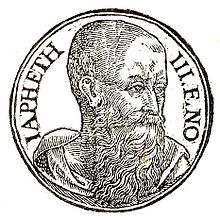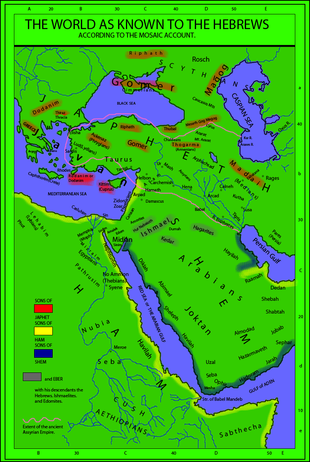Japheth
From Wikipedia, the free encyclopedia
For other uses, see Japheth (disambiguation).
| This article needs additional citations for verification. (January 2010) |
| Japheth | |
|---|---|

Japheth, as depicted in Promptuarii Iconum Insigniorum (c. 1553)
|
|
| Born | 1557 AM (date disputed)[1] |
| Children | Gomer Magog Madai Javan Tubal Meshech Tiras |
| Parents | Noah |
Contents
Order of birth
Japheth is often regarded as the youngest son, though some traditions regard him as the eldest. They are listed in the order "Shem, Ham, and Japheth" in Genesis 5:32 and 9:18, but treated in the reverse order in chapter 10.Genesis 10:21 refers to relative ages of Japheth and his brother Shem, but with sufficient ambiguity to have given rise to different translations. The verse is translated in the KJV as follows, "Unto Shem also, the father of all the children of Eber, the brother of Japheth the elder, even to him were children born". However, the Revised Standard Version reads, "To Shem also, the father of all the children of Eber, the elder brother of Japheth, children were born." The differing interpretations depend on whether the Hebrew word ha-gadol ("the elder") is taken as grammatically referring to Japheth, or Shem.
Genesis 5:32 states that Noah had three sons when he was five hundred years old. Genesis 11:10 records that Shem was one hundred years old when his son Arphaxad was born, two years after the Flood. If Noah was six hundred years old (Genesis 7:13), then Shem was ninety-eight years old at the Flood. Ham is further implied to be the middle son in Gen. 9:24 (which says Noah realized what his "younger son" had done to him.)
The Book of Jubilees indicates in 4:33 that Shem was born in the year of the world (after creation) 1205, Ham in 1209, and Japheth in 1211.
Place in Noah's family
Main article: Sons of Noah
For those who take the genealogies of Genesis to be historically accurate, Japheth is commonly believed to be the father of the Europeans. The link between Japheth and the Europeans stems from Genesis
10:5, which states, "By these were the isles of the Gentiles divided in
their lands." According to that book, Japheth and his two brothers formed the three major races:- Japheth is the father of the Japhetic race
- Shem is the father of the Semitic race
- Ham is the father of the Hamitic race
- ...they will be kin to us, or they will fetch it from Japhet. (II.ii 117-18)
Descendants
Main article: Japhetic

Geographic identifications of Flavius Josephus, c. 100 AD; Japheth's sons shown in red
- "Japhet, the son of Noah, had seven sons: they inhabited so, that, beginning at the mountains Taurus and Amanus, they proceeded along Asia, as far as the river Tanais (Don), and along Europe to Cadiz; and settling themselves on the lands which they light upon, which none had inhabited before, they called the nations by their own names."
The "Book of Jasher", published in the 17th century, provides some new names for Japheth's grandchildren not seen in the Bible or any other source, and provided a much more detailed genealogy (see Japhetic).
In Islam
Japheth is not mentioned by name in the Qur'an but is referred to indirectly in the narrative of Noah (VII: 64, X: 73, XI: 40, XXIII: 27, XXVI: 119). Muslim exegesis, however, names all of Noah's sons, and these include Japheth.[2] In identifying Japheth's descendants, Muslim exegesis more-or-less agrees with the Biblical traditions.[3] He is usually regarded as the ancestor of the Gog and Magog tribes, and, at times, of the Turks and Khazars. Some traditions narrated that 36 languages of the world could be traced back to Japheth.[4]Ethnic legends
In the seventh century, Isidore of Seville published his noted history, in which he traces the origins of most of the nations of Europe back to Japheth.[5] Scholars in almost every European nation continued to repeat and improve upon Saint Isidore's assertion of descent from Noah through Japheth into the nineteenth century.[6]Georgian nationalist historians such as Ivane Javakhishvili associated Japheth's sons with certain ancient tribes, called Tubals (Tabals, Tibarenoi in Greek) and Meshechs (Meshekhs/Mosokhs, Moschoi in Greek), who they claim represent non-Indo-European and non-Semitic, possibly "Proto-Iberian" tribes of Asia Minor of the 3rd-1st millennia BC.[7]
In the Polish tradition of Sarmatism, the Sarmatians were said to be descended from Japheth, son of Noah, enabling the Polish nobility to imagine themselves able to trace their ancestry directly to Noah.[6]
In Scotland, histories tracing the Scottish people to Japheth were published as late as George Chalmers' well-received Caledonia, published in 3 volumes from 1807 to 1824.[8]
Proposed correlations with deities
In the 19th century, Biblical syncretists associated the sons of Noah with ancient pagan gods.[citation needed]Japheth has been identified by some scholars with figures from other religious systems and mythologies, including Iapetus (Japetus), the Greek Titan;[9][10][11] the Indian figures Dyaus Pitar[citation needed] and Pra-Japati[citation needed], and the Roman Iu-Pater or "Father Jove", which became Jupiter.[citation needed]

No comments:
Post a Comment